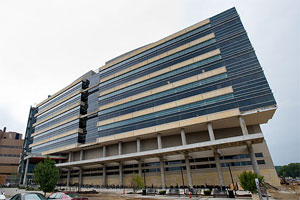
Research is organized by themes, such as breast cancer or cardiovascular research, in the Wisconsin Institutes for Medical Research. By freeing scientists and researchers from traditional departmental silos, the Institute encourages collaboration and discovery.
- One heart attack every 20 seconds
- One cardiovascular death every 39 seconds
- 1.2 million heart attacks a year in the United States; a third result in death
Richard Moss, senior associate dean for research in the UW School of Medicine and Public Health (SMPH), easily makes the case for the deadly impact of cardiovascular diseases. The Rennebohm Professor of Cell and Regenerative Biology and director of the University of Wisconsin Cardiovascular Research Center also works diligently in his lab to do something about it. “This is a huge problem … that needs to be addressed,” Moss said.
In a presentation March 20 for the Bascom Hill members, Moss discussed the School’s commitment to translational medicine – or moving discoveries from the laboratory into practical, patient care. Moss’ talk was part of the Showcase Luncheon Series; six are presented each year and are open to members of the Bascom Hill Society, which recognizes major donors to the University.
“The heart, for all the ways we can insult it, is really built to last,” Moss said. “It is a remarkable organism. In fact, it’s not happy if it’s not beating.”
The School of Medicine and Public Health has a long been a leader in heart disease research, he said. The first academic cardiovascular disease prevention program was established at the UW-Madison, where scientists also identified the heart-healthy benefits of aspirin and connected hypertension to sleep apnea. UW-Madison researchers continue their pioneering work as they explore the potential of stem cells to treat cardiovascular disease, Moss said.
Stem cells are pluripotent, which means they can become any cell in the body. In addition to embryonic stem cells, researchers have induced skin cells to revert to the pluripotent state. UW-Madison scientists were the first to create beating heart cells from both embryonic and induced pluripontent stem cells.
Despite the progress, Moss said, “we’re still a long way from therapeutic application.” Both embryonic and induced pluripotent stem cells pose problems, he said. “We don’t know which will be the best vehicle for a particular disease.”
The availability of human-induced pluripontent cells, however, is allowing scientists to move away from mouse models, Moss said. That brings research into the human realm. Recently, scientists have begun placing induced pluripotent stem cells in a trough, manipulating them to become a strip of heart muscle. This engineered cardiac tissue can be used for basic research to understand how the cells function, Moss said. It can be used to study diseases and to see how human cells react to those diseases. It can allow researchers to test drugs on human tissue and to develop therapies.
From the growth of blood vessels and irregular heart rhythms to coronary artery disease, disease prevention, heart failure and inherited cardiovascular disease, researchers in the UW School of Medicine and Public Health are exploring the gamut of cardiovascular health and disease, Moss said. “Virtually all of them have an eye on intervening in the disease process,” he added.
The University’s Inherited Arrhythmia Clinic brings science, patient care and genetics together, each contributing to the other. Arrhythmias are irregular heart rhythms, and the most common inherited arrhythmia is Long QT Syndrome, in which a heart takes longer than normal to contract and relax for one heartbeat. The longer beat destabilizes the electrical activity of the heart, and an adrenalin surge can flip it into chaos, Moss said. Young athletes who suddenly die of heart failure often have an inherited arrhythmia. In the clinic, patients are diagnosed and treated; their genetic history is explored, and scientists use the information to understand the course of the disease and develop new therapies.
Cardiovascular research is among the work that will move into the second tower of the Wisconsin Institutes for Research, currently under construction, Moss said. The tower also will include room for eye, neurodegenerative disease and regenerative medicine research. The Carbone Cancer Center occupies most of the first tower.
The towers, which are organized by disease, not traditional departments, offer a new way to work, Moss said. They enhance interaction among scientists and physicians and connect science closely to the neighboring UW Hospital and Clinics. “They work shoulder to shoulder,” he said of the scientists and clinicians. They go back and forth between the lab venue and the patient venue.
State dollars will cover half the cost of the $134 million second tower. A federal grant covers $15 million, and $28 million of the $52 million in private support needed to complete the building has been raised. The shell of the tower is complete, and builders are finishing the research floors for occupation in 2013.
